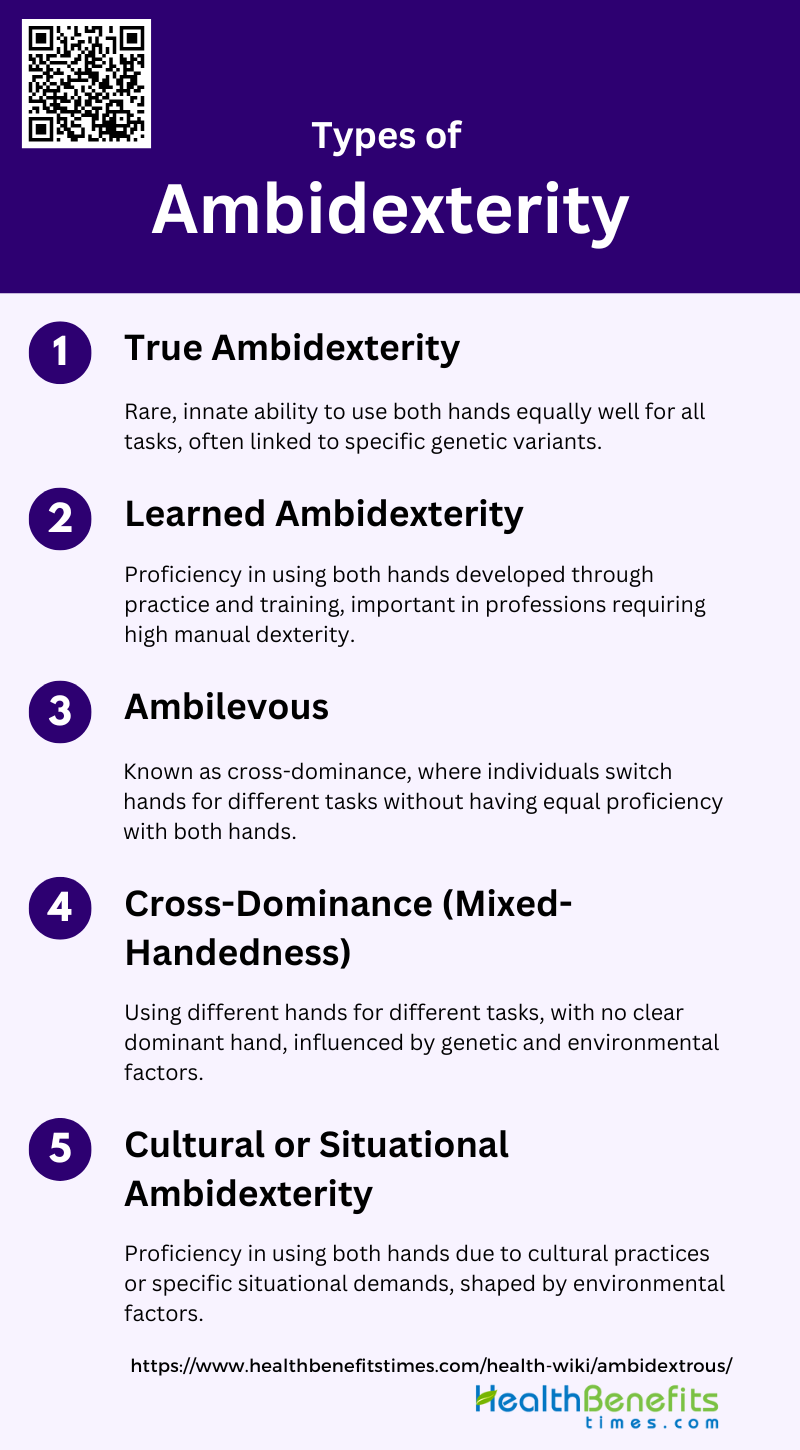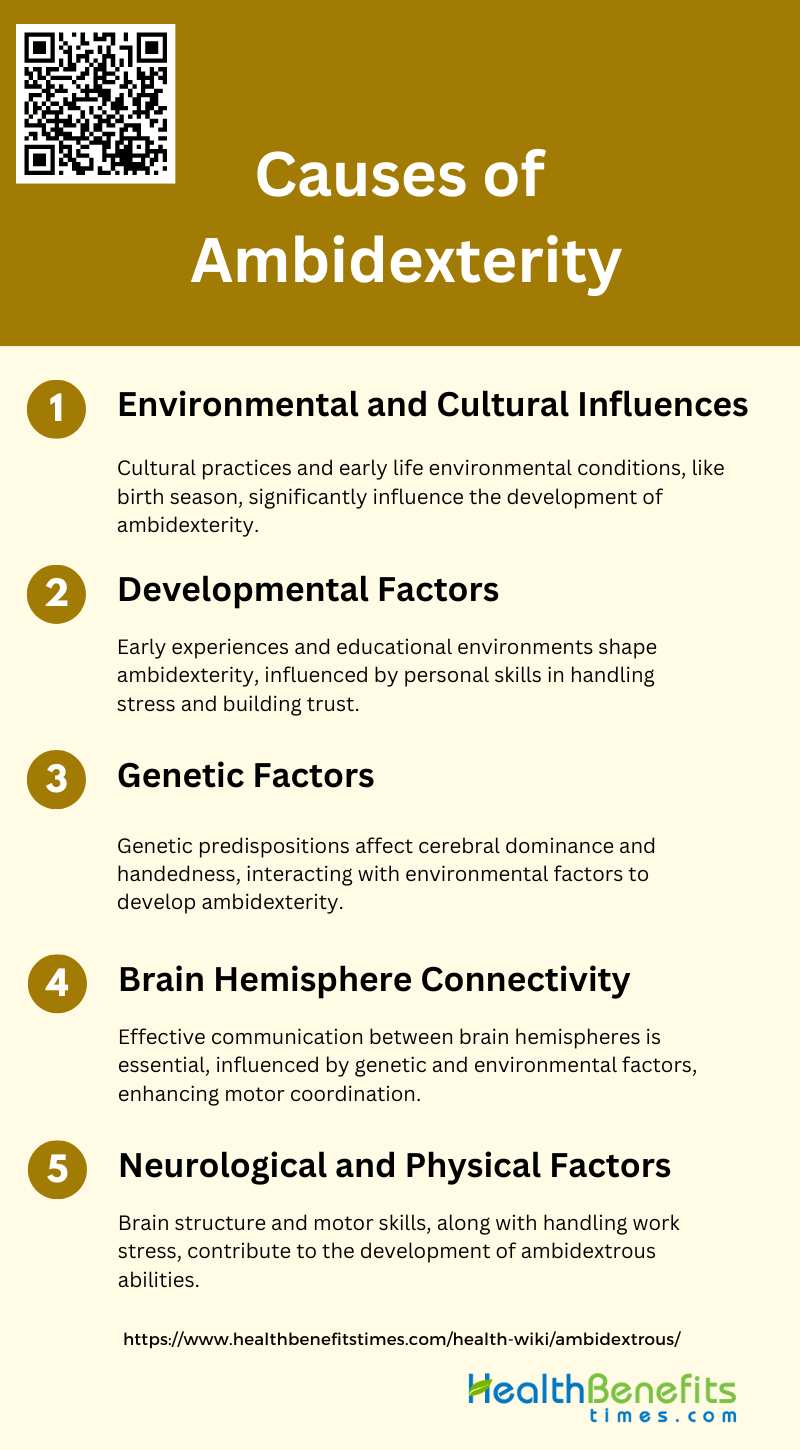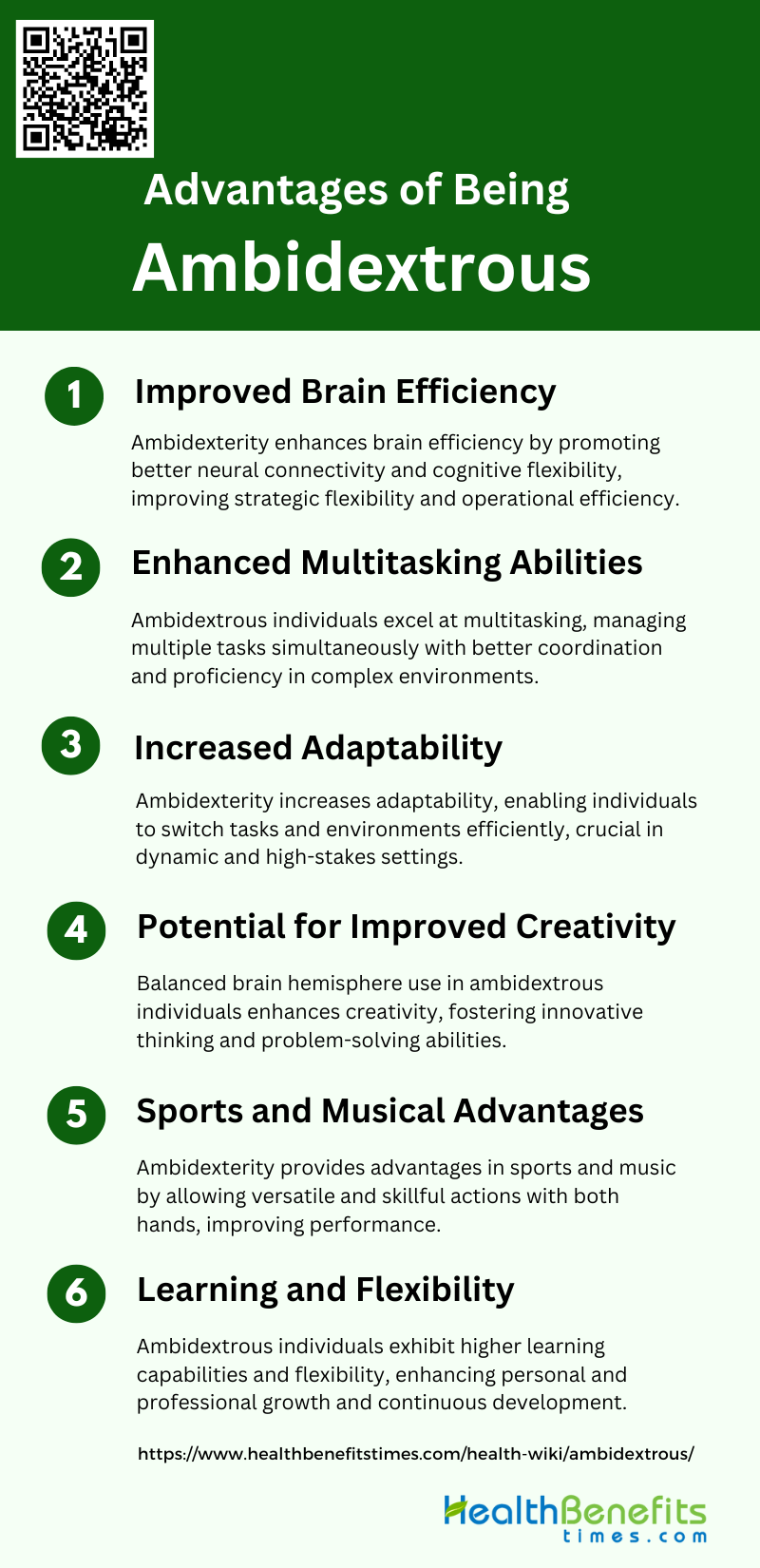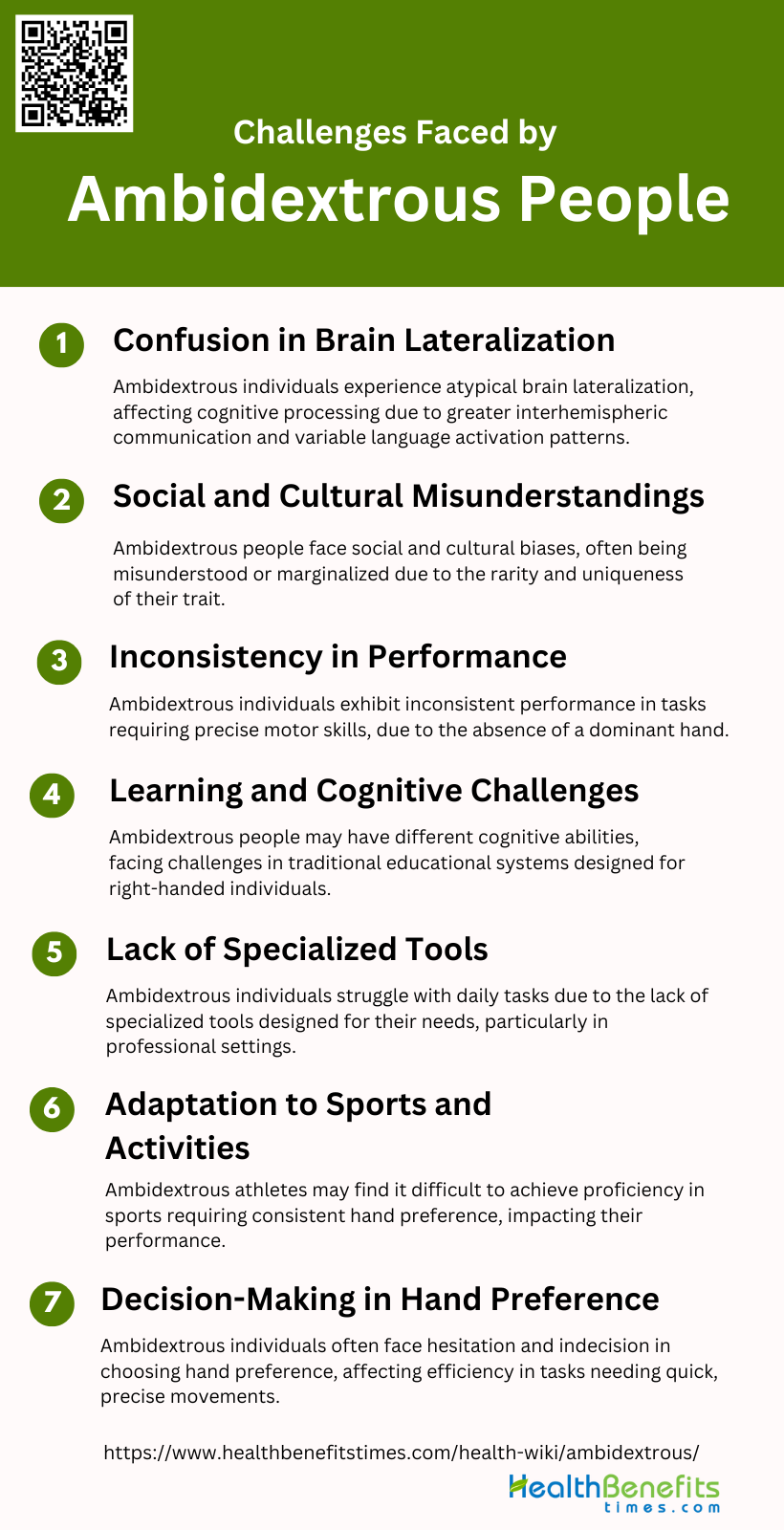Ambidextrous refers to the ability to use both hands with equal skill and dexterity. This rare trait is present in only about 1% of the population, which equates to approximately 80 million people worldwide. While most individuals have a dominant hand (either right or left) that they prefer for tasks requiring fine motor skills, ambidextrous people can perform such tasks equally well with either hand. This ability extends beyond just writing and can include activities like throwing, eating, or using tools. It’s important to note that true ambidexterity is different from mixed-handedness, where a person may prefer different hands for different tasks. Some ambidextrous individuals may have developed this skill through practice or necessity, such as left-handed people adapting to right-handed tools, while others may have a natural predisposition towards using both hands equally.
Types of Ambidexterity
It generally refers to the ability to use both hands with equal skill. However, in a broader context, especially in organizational and cognitive sciences, ambidexterity can be categorized into several types:
1. True Ambidexterity
True ambidexterity refers to the rare ability of an individual to use both hands with equal skill and dexterity. This form of ambidexterity is often considered innate and is not commonly found in the general population. Genetic studies have shown that true ambidexterity is associated with specific genetic variants, although these are distinct from those linked to left-handedness. True ambidexterity can be advantageous in various fields, such as sports and surgery, where the ability to perform tasks with either hand can enhance performance and efficiency.
2. Learned Ambidexterity
Learned ambidexterity is the ability to use both hands proficiently, developed through practice and training rather than being an innate trait. This type of ambidexterity is particularly relevant in professions requiring high levels of manual dexterity, such as neurosurgery and laparoscopic surgery. Studies have shown that with consistent practice, individuals can improve their non-dominant hand’s skills, leading to better overall performance in tasks requiring bilateral coordination. This acquired skill can be crucial in situations where reliance on a single hand is not feasible or optimal.
3. Ambilevous
Ambilevous, also known as cross-dominance or mixed-handedness, refers to individuals who do not have a strong preference for one hand over the other and may switch hands depending on the task. Unlike true ambidexterity, ambilevous individuals may not have equal proficiency with both hands but can use either hand for different activities. This trait is less about equal skill and more about flexibility in hand usage. Research indicates that ambilevous individuals may have unique neural pathways that allow for this flexibility, although it is not as well understood as other forms of handedness.
4. Cross-Dominance (Mixed-Handedness)
Cross-dominance, or mixed-handedness, is characterized by the use of different hands for different tasks, without a clear dominant hand. This form of ambidexterity is relatively common and can be seen in individuals who might write with one hand but perform other tasks, such as throwing a ball, with the opposite hand. Studies suggest that cross-dominance may be linked to specific genetic and environmental factors that influence hand preference and motor skills. This trait can be advantageous in various activities that require diverse hand movements and coordination.
5. Cultural or Situational Ambidexterity
Cultural or situational ambidexterity refers to the ability to use both hands proficiently due to cultural practices or specific situational demands. In some cultures, individuals are encouraged to develop ambidextrous skills from a young age, leading to a higher prevalence of ambidexterity in those populations. Additionally, certain professions or activities may necessitate the use of both hands, prompting individuals to develop ambidextrous abilities. This form of ambidexterity highlights the role of environmental and cultural factors in shaping hand preference and dexterity.
Causes of Ambidextrous
These factors can be broadly categorized into genetic influences, environmental conditioning, and neurological development. Below are some of the primary causes of ambidexterity:
1. Environmental and Cultural Influences
Environmental and cultural factors play a significant role in the development of ambidexterity. Research indicates that organizational culture, particularly one that supports alignment and adaptability, is crucial for fostering ambidexterity within firms. For instance, a study found that environmental munificence strengthens the relationship between ambidextrous organizational culture and contextual ambidexterity, leading to improved innovation outcomes. Additionally, the gestational environment, such as birth season, has been shown to influence lateral dominance, suggesting that environmental factors during early development can impact ambidexterity.
2. Developmental Factors
Developmental factors, including early life experiences and educational environments, significantly influence ambidexterity. Studies have shown that individual ambidexterity is affected by personal skills in handling work stress and building trust, which are developed over time through various experiences. Furthermore, the relationship between lateral dominance and birth season highlights the impact of developmental timing on ambidexterity, suggesting that the conditions during gestation and early childhood can shape an individual’s ability to use both hands effectively.
3. Genetic Factors
Genetic factors are also crucial in determining ambidexterity. Some researchers argue that cerebral dominance and laterality are genetically determined, similar to traits like eye color and blood type. This genetic predisposition can influence whether an individual is right-handed, left-handed, or ambidextrous. However, the interplay between genetic and environmental factors is complex, and both contribute to the development of ambidexterity. For example, while genetic factors set the foundation, environmental influences during gestation and early life can modify these genetic predispositions.
4. Brain Hemisphere Connectivity
The connectivity between brain hemispheres is a fundamental factor in ambidexterity. Effective communication between the left and right hemispheres of the brain is essential for coordinated use of both hands. Research on cerebral laterality suggests that both genetic and environmental factors influence this connectivity, impacting an individual’s ability to develop ambidextrous skills. Enhanced inter-hemispheric communication can lead to better integration of motor functions, thereby facilitating ambidexterity.
5. Neurological and Physical Factors
Neurological and physical factors, including brain structure and motor skills, are critical in the development of ambidexterity. Studies have shown that organizational trust and formalization can influence ambidexterity by affecting neurological and physical responses to tasks. Additionally, individual skills in handling work stress and building trust are linked to better performance and ambidextrous behavior, indicating that neurological resilience and physical adaptability are important for ambidexterity. These factors collectively contribute to an individual’s ability to use both hands effectively in various tasks.
Advantages of Being Ambidextrous
Being ambidextrous, or having the ability to use both hands with equal skill, offers numerous benefits. These advantages span across various aspects of life, from improved brain function to enhanced adaptability in daily tasks. Below are some key advantages of being ambidextrous:
1. Improved Brain Efficiency
Being ambidextrous can lead to improved brain efficiency by enhancing the brain’s ability to process information and perform tasks. This is because ambidexterity involves the use of both hemispheres of the brain, promoting better neural connectivity and cognitive flexibility. Studies have shown that ambidextrous individuals often exhibit higher levels of strategic flexibility and operational efficiency, as their brains are adept at switching between different types of tasks and problem-solving approaches.
2. Enhanced Multitasking Abilities
Ambidextrous individuals often excel at multitasking due to their ability to use both hands with equal proficiency. This skill translates into better coordination and the ability to manage multiple tasks simultaneously. Research indicates that ambidextrous capabilities can enhance an individual’s ability to balance exploration and exploitation activities, which are essential for effective multitasking in complex environments.
3. Increased Adaptability
This adaptability is crucial in dynamic and fast-changing settings, such as competitive business environments or high-stakes professions like neurosurgery. The ability to use both hands proficiently can help individuals quickly adjust to new challenges and maintain high performance under varying conditions.
4. Potential for Improved Creativity
Ambidextrous individuals may experience enhanced creativity due to the balanced use of both brain hemispheres, which can lead to more innovative thinking and problem-solving. Research has shown that ambidextrous knowledge and learning capabilities significantly boost employee creativity and sustainable innovation performance. This is because the integration of different types of knowledge fosters the development of new ideas and creative solutions.
5. Sports and Musical Advantages
In sports and music, ambidexterity can provide a significant advantage by allowing individuals to perform actions with both hands, leading to greater versatility and skill. For instance, ambidextrous athletes can switch hands to gain a competitive edge, while musicians can play instruments more fluidly. Studies have demonstrated that motor training programs designed to develop ambidextrous laterality can significantly improve sports skills in children, highlighting the practical benefits of ambidexterity in physical activities.
6. Learning and Flexibility
The ability to use both hands proficiently can enhance one’s capacity to learn new skills and adapt to different learning environments. Research indicates that firms with employees who possess high learning capabilities and ambidextrous knowledge are more likely to achieve sustainable innovation and competitive advantage, underscoring the importance of ambidexterity in fostering continuous learning and development.
Challenges Faced by Ambidextrous People
While being ambidextrous offers unique advantages, it also presents several challenges. These challenges can affect various aspects of life, from cognitive processing to social interactions. Below are some of the common challenges faced by ambidextrous individuals:
1. Confusion in Brain Lateralization
Studies have shown that ambidextrous people exhibit a higher incidence of atypical language lateralization compared to right-handed individuals, with a significant portion displaying either right-hemispheric or symmetric activation patterns during language tasks. This atypical lateralization can lead to challenges in cognitive processing and may be linked to the larger corpus callosum found in ambidextrous individuals, which facilitates greater interhemispheric communication.
2. Social and Cultural Misunderstandings
Ambidextrous individuals may face social and cultural misunderstandings due to the rarity and uniqueness of their trait. In many cultures, there is a strong preference for right-handedness, and deviations from this norm can lead to misconceptions and biases. For instance, ambidextrous people might be perceived as indecisive or inconsistent, which can affect their social interactions and acceptance in certain communities. Additionally, the lack of awareness and understanding about ambidexterity can result in ambidextrous individuals being unfairly judged or marginalized.
3. Inconsistency in Performance
Ambidextrous individuals often exhibit inconsistency in performance across various tasks. This inconsistency can be attributed to the lack of a dominant hand, which may lead to variability in motor skills and coordination. For example, in surgical training, ambidextrous surgeons might struggle with tasks that require precise hand movements, as they need to constantly switch between hands, leading to potential errors and inefficiencies. Similarly, in sports, ambidextrous athletes may find it challenging to develop a consistent technique, impacting their overall performance.
4. Learning and Cognitive Challenges
Research indicates that ambidextrous people might have different cognitive abilities compared to right-handed individuals, with some studies suggesting that they may have lower spatial abilities and less lateralized speech patterns. These differences can affect their learning processes and academic performance, as traditional educational systems are often designed with right-handed individuals in mind, potentially putting ambidextrous students at a disadvantage.
5. Lack of Specialized Tools
The lack of specialized tools and resources for ambidextrous individuals can pose significant challenges in their daily lives. Most tools and equipment are designed for right-handed users, making it difficult for ambidextrous people to find suitable options that cater to their needs. This issue is particularly evident in fields such as surgery, where the default setup for instruments and equipment is often right-handed, forcing ambidextrous surgeons to adapt or compromise their technique. The absence of ambidextrous-friendly tools can hinder their efficiency and effectiveness in various tasks.
6. Adaptation to Sports and Activities
Adapting to sports and activities can be challenging for ambidextrous individuals due to the need for consistent hand preference and technique. In sports, where specific skills and movements are typically honed with one dominant hand, ambidextrous athletes may struggle to achieve the same level of proficiency as their right- or left-handed counterparts. However, with targeted training programs, such as those involving racket sports, ambidextrous individuals can develop their skills and improve their performance, demonstrating that ambidexterity can be nurtured and leveraged for success in sports.
7. Decision-Making in Hand Preference
Ambidextrous individuals often face difficulties in decision-making regarding hand preference, which can impact their efficiency and effectiveness in various tasks. The constant need to choose between hands can lead to hesitation and indecision, affecting their performance in activities that require quick and precise hand movements. This challenge is particularly relevant in high-stakes professions such as surgery, where the ability to make swift and confident decisions is crucial for success. Developing a clear hand preference through practice and training can help ambidextrous individuals overcome this challenge and enhance their overall performance.






